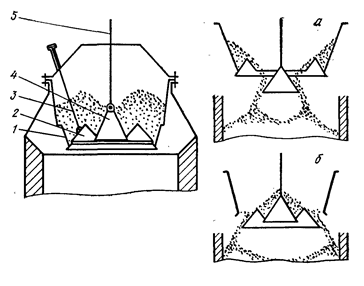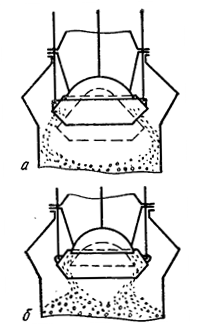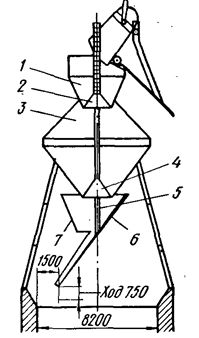Ferrous metals
Introduction. Metallurgical industry in Ukraine has been and remains the basic industries, focused mainly on their own raw materials and energy resources, and blast-furnace smelting is the main way to obtain iron. At the same time, Ukraine blast furnace largely worn and need overhauls. Therefore, it is advisable to focus primarily on the problems of reconstruction and modernization of blast furnaces Ukraine. One of the main ways to achieve minimum fuel consumption for pig iron production at a given level of charge in the current environment is the management of the distribution of the burden on the throat to provide the desired structure formation column charge materials and gas distribution over the cross section of the furnace. Create a bell-less charging devices (BSC), has led to a significant change in management techniques downloading the blast furnace. Loading chute distributor allows the distribution of the burden without shifting the slope profile of the grist with most of the raw materials remains in the throat of the annular zones, where they are loaded valve. This is true for the elimination of violations of the furnace in a circle, accompanied by tilting the surface profile of the grist.Relevance of the topic. Using the BSC will: better manage load materials and allows for more uniform distribution of the burden without shifting the slope profile of the grist with most of the raw materials remains in the throat of the annular zones, where they are loaded distributor; impact on gas dynamics of the furnace and reducing coke consumption by 1-5%; reducing harmful emissions into the environment.The purpose and objectives of the study. Evaluate the effectiveness of controlling the distribution of charge materials and gases in a blast furnace at various loading systems. To investigate the effect of the distribution of materials in the course of a blast furnace and the technical and economic indicators.
To work with a higher gas pressure on the throat decreased resistance zasypnyh devices of the type design, as a result of this there were various options to increase the service life of standard memory, by modernization. [1] So a number of countries trying to upgrade memory in winning reliability and thus provide a better radial distribution of materials. In Sweden, it was suggested Sharlevillya unit with no moving cone firmly fixed on the traverse.

1 - receiving hopper; 2 - movable cone; 3 - mounting feet; 4 - fixed cone; 5 - traverse; 6 - Rod
Figure 1 –Charge Sharlevill’s unit system.
But as it turns out design is not reliable because of the loose fit of the movable cone to the hopper, there was a strong flue gas content area. This disadvantage served ugoraniyu workers at them. Dzerzhinsky, where there was this unit. After this part of the material unloading systems at the center of the oven provided a good gas distribution and a low coke consumption, but it acts on the smaller furnaces for the large central gas flow is reduced due to supply peripheral blast that led to the charge with taut immediately hang and precipitation. In 1959 in France, was proposed and patented by the filling apparatus to the presence of retainers hold enable distribution ring in the upper position during the filling material into the intermediate zone. This unit had a single ring grist charge, but you can adjust the comb downloading materials in peripheral (Figure 2 b) and the intermediate (Figure 2a) zone of the furnace.

1 cup; 2 - conical distribution ring; 3 - inclined thrust; 4 - cone; 5 - Rod
Figure 2 - Sediment device with additional distribution ring.
In the USSR, a similar device was proposed by P. Zlokazov. Thicket and in its lower cone apparatus of conventional design, but a smaller diameter.

Figure 3 - Scheme action charging gears designs P. Zlokazov (a, b)
Under the lower cone, an additional funnel in the form of two truncated cones welded wide bases with two rods. I f a funnel lowered together with the cone, the charge materials are exposed to the walls of the throat of figure (Figure 3a) and in the case of lowering the cone material will fall in to the intermediate or central zone (Figure 3b) [1]. For continuous movement of fines in the intermediate zone radial section of the blast furnace at the plant them Lenin offered a central arm (V. Tarasov, P. Tarasov, V. Dolmatov).

1 - Rod; 2 - the filling machine; 3 - the central arm.
Figure 4 - The central arm for the radial distribution of charge.
This unit consists of a dome-shaped funnel, suspended on a rod to a special electric- or hydraulic, provide lift or lower. Pointing also has openings for gas outlet from the central zone to the gas outlet. Its main application - preventing ingress of fine fraction of the charge in the axial zone of the furnace and the distribution of fines across the width of the intermediate zone. Adjusts the amount of detail varying height lowering of the upper arm position before depositing it into the charge. Advantages of this device: 1) Simplicity of design; 2) Does not reduce tightness backfill apparatus; 3) precludes Bulk material that does not entail the deterioration of the horizontal distribution [1]. Construction BSC with the location of the switchgear in the furnace has been proposed in 1958 by E. Wegman and A. Vagin. In this design, upgraded in 1963, it has been provided with two guide funnel with boot flaps, operating as sealing valves. Small cone and distribution chute supported by three supporting rollers disposed at 120 degrees. Rotating the chute by means of rollers having an individual drive.

1 - Reception Wronki; 2 small cone; 3 - intermediate hopper; 4 - a lower cone;5 - Rod; 6 - Tray; 7 - sectoral bump.
Figure 5 - Sediment device blast furnace system E. Wegman and A. Vagin.
This device to blast furnace improves the TEP blast furnace. Using a rotary feeder ensures high circumferential uniformity of the charge, a flexible and effective distribution of materials regulation radially furnace. Operating Experience (was established on ZSMK and Bhilai Steel Plant, India) showed that the use of this device comes to increase in production of pig iron 4,3-6,7% and savings of coke - 4.1-4.4% [ 3]. FPS is a modern boot device of the new generation. The main feature of this device is the presence of the rotary batch distributor, the main working body which is located inside the oven and is designed as a five-blade propeller - rotor. General view of the FPS is shown in Figure 6.

1 - FSPEF; 2 - Guiding funnel; 3 - reception hopper; 4 - small cone; 5 - intermediate bunker; 6 - large cone; 7 - Correcting ring; 8 - camera gear; 9 - flue flange; 10 - rotary distributor
Figure 6 - General view of rotary boot device
The structure of FPS includes top and bottom of the cone, five-blade rotor and its drive, receiving and guiding funnel intermediate hopper with a corrective ring, cooling system and lubrication, and automated control system (ACS) "Rotor". FPS is mounted directly on the flange of the blast furnace blast furnace. In its high-rise does not exceed the size of FPS normal size double-cone machine. Therefore, when it is installed on existing furnaces do not require reconstruction of the dome of the oven, copra and sloping top of the bridge, and not lost the useful volume of the furnace. Procedure of FPS in terms of receiving and locking the charge similar to the double-cone unit. Upon opening of the lower cone charge enters the body cavity through the drive rotor and the annular gap formed by the neck of the funnel and the lower cylindrical portion of the bevel gear chamber is supplied to the rotating rotor blades five. On the surface of the blades is formed of five streams of charge materials that are uniformly distributed around the circumference, is formed on the throat of the annular ridge with gentle slopes.
The essence of the new concept of downloading implemented rotary batch distributor, is a "soft" fan and multilayer stacking the raw material on the throat of the blast furnace. [3] In known memory (Cone or tray type), the material moves along the inclined surface of the working body of the distributor linearly in a radial direction and then discharged into the furnace by acquiring the time of incidence on the surface of the grist sufficiently high kinetic energy. As a result, when unloading the materials into the furnace, the deformation of the underlying layers and are difficult to control distribution change materials. The FPS nature of goods movement along the inclined surface of the rotary distributor is fundamentally different from the movement of the material cone and the tray. The material moves along the rotor blade non-straight, and in a fairly wide range of curved paths, depending on the rotor speed and the type of feed material. Scattering on the surface of the blade, the material coming from her wide fan, and a large part of the flow is not prevalent radial and tangential component of the velocity. When the fan load is greatly reduced kinetic energy of the materials as they fall to the surface of the grist, which allows for so-called "soft" load at which excludes the deformation of underlying layers. Grist profile thus has relatively small slope angles, thereby restricting oversleeping materials and their particle size segregation. If you change the speed of the rotor crest materials can be moved from one annular zone to another furnace throat smoothly, without sudden fracture profile, which also allows you to smoothly change the radial load of ore furnace. Due to the five vanes during one revolution of the rotor on the throat formed five layers of material and during discharging a portion stacked on average 30-40 layers of material. Multithreaded multilayer loading charge is another important feature of the new concept of the blast furnace loading. It allows you to significantly improve the uniformity of the load in the circumferential direction; moreover, the averaging materials discharged from the intermediate hopper, both chemical and grain composition. The radius of the annular ridge depends on the speed and direction of rotation of the rotor. As the rotor rotates in the direction of inclination of the blades, and the average loaded peripheral furnace top zone, while rotating in the opposite direction - the central part
ПThe following modes download the raw materials:
loading ring when the entire portion of material is discharged by a predetermined radius at a constant rotor speed;
multiring loading when a portion of material is distributed to several adjacent annular zones, while the rotation speed of the rotor and a radius crest stacking changed stepwise;
spiral load when serving distributed in predetermined zones adjacent ring by continuously changing the rotor speed and the radius of laying ridge forming materials on the throat multithread coil [4].
In case of an emergency stop the rotor charge materials are poured on the stationary blade, forming a five grist conical hills, peaks which are evenly distributed around the circumference with a radius equal to approximately half the radius of the furnace top. In such a situation, not necessarily immediately terminate the download, and the oven for at least several hours, can proceed without any major deviation from the normal course.
Sustainable global trend in the blast furnace production is the use of bell-less charging devices (BLT). Most widely used BLT firm "Paul Wurth," which in 1972 developed a memory, using the principle of the distribution chute inside the furnace see. Figure 7. The main advantages of this design trough BLT: selective distribution of the raw materials for the whole area of the furnace top with the software download mode ring, a multiple-oriented (point), the sector [5].

1 - the conveyor; 2 - receiving hopper; 3 - zaslonka hopper; 4 - upper gazouplotnitelny valve; 5 - intermediate hopper; 6 - leads charge the gate; 7 - lower gazouplotnitelny valve; 8 - interception device; 9 - gear; 10 - rotary batch distributor – Tray
Figure 7 - Diagram of bell-less charging device to the distributor chute
One of the key issues of the distribution of the raw materials BLT tray type is the lack of laws unloading materials from bins at a constant angle of opening shutter of charge. Options expiration materials from bunkers are determined not only the opening angle of the gate, but the accuracy of its installation, kolebaemostyu size distribution of the materials, the uneven nature of the expiration of the charge through the opening gate of charge, constant section. Thus, the quality of the raw material distribution around the circumference and radius of the throat of depends on the variables and unpredictable factors, which greatly reduces the technological possibilities of BLT. In accordance with the loading charge of company BLT P.Wurth transition tray from one angular position to another is subject to the equality remaining weight materials created job. And bin and the tray are not linked, increasing the accuracy of the division portion material angular positions tilt tray [3]. Table 1 shows the distribution of the mass of material on the positions of the tray. In the blast furnace №9 SM "Krivorozhstal" during the transition to another tray with the angular position of the rotational speed of 2.67 / min, compared to 8 / min at a certain angular position, left a large mass of material in the hopper against a given. Table 1a shows that the error in this case is slightly decreased to 14-20%. An exception was the distribution of agglomerate and sinter with pellets, where the error was from 23.9% to 30%.
Table 1 - speed of descent from the tray
| Speed , м/с | The angle of inclination of the chute. | |
| BF6 NLMP | BF9 Kriv.Steel | |
| 4,51 | 4,64 | 50,6 |
| 5,1 | 4,9 | 46,5 |
| 5,45 | 5,07 | 44,0 |
| 5,74 | 5,23 | 41,5 |
| 5,97 | 5,37 | 39,0 |
| 6,13 | 5,5 | 36,5 |
| 6,28 | 5.64 | 33,5 |
| 6,40 | 5,76 | 30,5 |
| 6,53 | 5,87 | 27,0 |
| 6,80 | 6,05 | 18,5 |
Table 1 shows that the rate of descent of the charge from the tray BLT BF №6 NLMP and BF №9 «Kryvorizhstal" at different angles vary little, even though the length of the tray in the first case, 3.5 m and 4.5 m in the second. The speed of descent of the charge from the tray when matching its direction from a central heat and with their opposite directions will be very different. Changing the terms of unloading the raw materials from the bunkers without the consent of the times they were unloading systems from a tray and change the speed of rotation of the tray at the moment of transition from one round to another (changing the angle of the tray) is influenced not only on the radial distribution of the raw materials, but also their circumferential distribution. The circumferential unevenness of the charge distribution on the throat using time of precipitation of the hopper constituted 2-5% compared to 8-11% without unevenness such regulation [3]. To reduce the non-uniformity of said proposed shipping charge with the open ring. In this case, the sectors on which the tray after the last ring closure continued motion and loading, the amount of ore materials has increased by 15-20% compared with a uniform distribution of [3]. Thus, rotation of the tray with a speed of 8 rev / min does not provide a uniform or close to that of the charge distribution along the circumference of the furnace. We know that stopping the rotating position of the tray in the garage, as well as the accuracy of the completion of turns poor.
Basic processing methods of controlling the distribution of materials and gases trough BLT type: